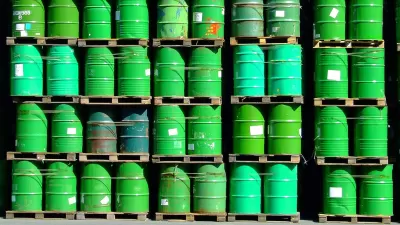Could Virginia, the state that did away with its gasoline excise tax entirely, be the template for a new federal transportation funding system? By using multiple taxes and fees, they present an alternative to simply raising the federal gas tax.
Senator Barbara Boxer (D-Calif.), chair of the Senate's Environment and Public Works Committee, suggested last month that Virginia's new funding scheme, particularly the new wholesale sales gas tax, could be a model for a replacement of the federal gas tax.
Nathan Hurst writes that Congress, "look(ing) for creative ways to shore up the Highway Trust Fund" in advance of the expiration of MAP-21 next September, is considering doing just what Boxer suggested by studying Virginia's new law as a possible template to consider.
According to Hurst, the main advantage of the wholesale tax is that it "would solve one of the central problems facing the trust fund by naturally adjusting for inflation."
The per-gallon tax of 18.4 cents for gasoline and 24.4 cents for diesel hasn’t been increased since 1993, so the trust fund’s buying power has steadily eroded with rising prices. Taxing a percentage of wholesale motor fuels costs would boost revenue as prices rise without forcing lawmakers to revisit the question with politically painful votes to raise taxes."
Of course, this assumes that the price of gas increases. Maintaining the excise tax, a path that neighboring Maryland took, would provide a healthy check on revenue should gas prices stabilize or decrease.
In fact, Virginia did away with its statewide 17.5 cents-per-gallon tax at the gas pump entirely, in favor of a new wholesale tax of 3.5 percent on gasoline and 6 percent on diesel, along with an increase in the state’s general sales tax. In the heavily populated Washington suburbs and Tidewater area, motorists pay an extra 2.1 percent sales tax on gas purchases. Drivers of electric [and hybrid] vehicles pay a $64 annual fee.
[Note: The 2.1 percent gasoline sales tax charged in certain northern Virginia suburbs predates the new law which maintained and expanded its reach. Chelyen Davis of The Free Lance-Star explains:
Drivers in Northern Virginia localities—including Spotsylvania, Stafford and Fredericksburg—already pay an extra 2.1 percent in gas tax for local roads, and the new law levies the additional 2.1 percent in Hampton Roads localities.
Furthermore, shoppers in these areas saw the general sales tax rise to 6 percent as opposed to 5.3 percent elsewhere when the new tax system was implemented on July 1, according to Davis.]
As noted above, Maryland maintained its 23.5-cent gas tax, adjusted it for inflation, and added a new wholesale gasoline sales tax, initially set at 1 percent and increasing to 2 percent in 2015.
However, it should be recognized that Virginia's new tax scheme is successful in that it raises more revenue than the 17.5-cent gas tax it replaced.
Sean T. Connaughton, Virginia’s Transportation secretary, says the wholesale tax should provide more long-term stability than the cents-per-gallon tax that it replaced.
“We were able to show our legislature that we weren’t going to have enough money, even for federal matches, by 2017,” he said.
Of course, applying the complex new tax scheme was no easy matter, as Davis writes.
“It’s the most convoluted thing you’ve ever seen,” said Virginia Petroleum, Convenience and Grocery Association president Michael O’Connor, adding that the tax change [effective July 1] has prompted more calls and questions from gas station owners than he’s seen in his 13 years at VPCGA.
Va. Gov. Bob McDonnell and the state legislature, like President Obama and Congress, were unwilling to raise an existing tax - so he came up with a complex alternative that raises more revenue than the current tax which hadn't been raised since 1986. While that may not be the best model to follow, it does present an attractive alternative to legislators trying so desperately to avoid a straightforward gas tax increase not done in 20 years, a path followed since the federal gas tax was first applied in 1932.
An alternative path would be to consider the proposal by Rep. Peter DeFazio (D-Ore.) to index the current 18.4-cent gas tax for inflation. Applying the index would mean that, at least initially, Congress could claim that they haven't increased a tax.
FULL STORY: Congress Eyes Virginia's Model for Funding Transportation Projects

Study: Maui’s Plan to Convert Vacation Rentals to Long-Term Housing Could Cause Nearly $1 Billion Economic Loss
The plan would reduce visitor accommodation by 25,% resulting in 1,900 jobs lost.

North Texas Transit Leaders Tout Benefits of TOD for Growing Region
At a summit focused on transit-oriented development, policymakers discussed how North Texas’ expanded light rail system can serve as a tool for economic growth.

Why Should We Subsidize Public Transportation?
Many public transit agencies face financial stress due to rising costs, declining fare revenue, and declining subsidies. Transit advocates must provide a strong business case for increasing public transit funding.

How to Make US Trains Faster
Changes to boarding platforms and a switch to electric trains could improve U.S. passenger rail service without the added cost of high-speed rail.

Columbia’s Revitalized ‘Loop’ Is a Hub for Local Entrepreneurs
A focus on small businesses is helping a commercial corridor in Columbia, Missouri thrive.

Invasive Insect Threatens Minnesota’s Ash Forests
The Emerald Ash Borer is a rapidly spreading invasive pest threatening Minnesota’s ash trees, and homeowners are encouraged to plant diverse replacement species, avoid moving ash firewood, and monitor for signs of infestation.
Urban Design for Planners 1: Software Tools
This six-course series explores essential urban design concepts using open source software and equips planners with the tools they need to participate fully in the urban design process.
Planning for Universal Design
Learn the tools for implementing Universal Design in planning regulations.
Ascent Environmental
Borough of Carlisle
Institute for Housing and Urban Development Studies (IHS)
City of Grandview
Harvard GSD Executive Education
Toledo-Lucas County Plan Commissions
Salt Lake City
NYU Wagner Graduate School of Public Service



























